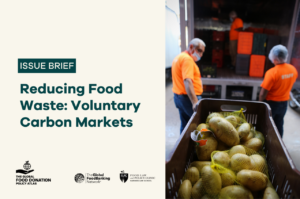
This post was written by Nathan Rosenberg and Peter Lehner.
The harsh realities of climate change are becoming more visible and dangerous throughout the world. While policymakers are beginning to enact measures to reduce reliance on fossil fuels, they still undervalue the need to reform our food systems to address climate change. Both November’s climate conference in Scotland and President Biden’s concurrently released plan to address the extremely potent greenhouse gas methane barely addressed agriculture at all, despite the fact that our food systems are the largest source of methane and ultimately responsible for a third of global warming. The reality is that we must reform agriculture because it is impossible to achieve the Paris Agreement goal of no more than 2 degrees Celsius (3.8 degrees Fahrenheit), much less the safer goal of 1.5°C (2.9°F) degrees, without doing so.
In response to this urgent need, we spent the last five years researching the science, law, and policy of climate change and agriculture in the United States. We’ve published our findings in a new book, Farming for Our Future: The Science, Law, and Policy of Climate-Neutral Agriculture. Intended for researchers, policymakers, and advocates alike, the book provides the first comprehensive overview of the law and policy of agricultural emissions in the United States. In addition to serving as an in-depth and authoritative review, we also hope the book will serve two other important purposes.
First, it’s designed to be a blueprint for policy change. In addition to surveying the state of the science on agricultural emissions and the existing legal and policy landscape, we include hundreds of regulatory, legal, and policy changes designed to reduce net emissions. Some of them are minor. Some are radical. All are intended to move us closer to zero net emissions in agriculture.
Second, it aims to change how readers see agriculture. After reading hundreds of papers, combing through previously unpublished data and documents (often acquired through Freedom of Information Act requests), and conducting interviews with advocates, government officials, scientists, and farmers, we’ve had to revise our own views many times, often on critical issues. We’ll have failed as writers if our readers don’t do the same. In the post that follows, we’ve laid out six of our most controversial—and important—findings.
1. Agricultural emissions are much higher than commonly understood.
The Environmental Protection Agency estimates that agriculture is responsible for about 10% of the country’s total greenhouse gas emissions. As we began to dive into the research, however, we found that this estimate undercounts agriculture’s actual emissions in four key ways. First, it doesn’t consider the current climate change impacts of prior land conversion or agricultural land’s ability to sequester more carbon—a significant omission since agriculture occupies over one billion acres in the US and over 60% of the contiguous land mass. Second, it doesn’t include a number of agricultural activities in its tally, such as on-farm energy usage, annual land use conversion, or the production of agricultural inputs; these are included elsewhere in EPA’s analysis. Third, EPA’s method for calculating the impact of methane is inconsistent with the need for short-term action and current near-term policy discussions, reducing its estimate of agriculture’s emissions by more than half. Finally, EPA relies on models with enormous uncertainty ranges to calculate greenhouse gas emissions from concentrated animal feeding operations (CAFOs) and hundreds of millions of acres of agricultural land. More recent research indicates these models are often overly conservative. Accounting for all these adjustments brings the total GHG emissions attributable to the agricultural sector to about one-third of all U.S. emissions.
EPA’s low number for agricultural greenhouse gas emissions often leads policymakers and journalists to focus on other sectors when considering climate change mitigation strategies. It also obscures the need to regulate the worst polluters in agriculture. As we discuss in the book, there are a small number of large-scale operations (primarily CAFOs and their suppliers) that are responsible for an immense share of the sector’s emissions, yet they are largely unregulated today. That must change if we are to achieve our climate goals.
2. Farmers are much smaller in number—and wealthier—than reported.
Media reports often present farmers as a large rural constituency that must struggle to earn a living. In our second chapter, co-authored with statistician Bryce Stucki, we use USDA data, government surveys, and tax records to show that this narrative is, at best, misleading. Official USDA figures vastly overstate the number of farmers by including hundreds of thousands of retirees, hobbyists, taxpayers with “paper farms” (so-classified for tax purposes), who together make up the majority of “farmers.” In addition to significantly inflating the number of farmers in the U.S., these non-farming farms sharply lower USDA’s official income figures since they aren’t intended to turn a profit and often don’t sell any products whatsoever. Moreover, a deeper analysis of survey data shows that the overwhelming majority of farmers are wealthy—even if you don’t count farm assets—and enjoy comfortable incomes.
This doesn’t mean that we should ignore the needs of farmers and ranchers when crafting new policies. On the contrary, we learned much from our visits to farms and ranches (including Peter’s own farms) while researching this book. But it does call into question the longstanding and often unstated assumption that U.S. farm policy should reflexively focus on the interests of farmers, even to the detriment of farmworkers, rural residents, and other constituencies. There are broad swaths of the rural population, much more numerous than farmers, who have a stake in reforming agricultural policy. Engaging these constituencies, together with those farmers already on the forefront of change, will be essential if these reforms are to be successful.
3. We can’t decarbonize agriculture without massively expanding perennial production.
Proposals to reduce agricultural emissions generally focus on animal agriculture and annual crops. This makes sense at first glance: almost all agricultural emissions come from their production. But while we need to fundamentally change animal agriculture and annual crop production, doing so won’t completely eliminate agriculture emissions. To do that we’ll need to substantially expand the number of trees, shrubs, and other perennial plants on our country’s farms and ranches, by intercropping tree crops, establishing perennial pastures, introducing riparian and field buffers, or adding trees to pasture, among other methods. This is because perennial plants produce dramatically more biomass than shorter-lived annuals (compare the roots and trunk of a tree to the roots and stem of a soybean plant) and this additional biomass stores additional carbon. The carbon stored within plants is also easier to track and verify than carbon stored in soil, which, as we discuss below, can be tricky to reliably measure. Even conservative estimates find that perennial practices sequester two to five times more carbon per acre than the most effective annual practices.
A growing number of farmers, researchers, and organizations are demonstrating that perennial agriculture can be just as productive as annual agriculture, while providing nutritious food and substantially better environmental outcomes. Unfortunately, U.S. farm policy discourages perennial agriculture, which, among other things, requires longer funding periods than annual crops. To give perennial agriculture equal footing (much less the leg up it warrants), we’ll need to make a series of important changes to USDA’s research, conservation, and subsidy programs.
4. We shouldn’t rely on long-term soil carbon sequestration to offset emissions elsewhere.
There are a number of public policy reasons to improve soil health, including its positive impact on agricultural productivity, water quality, and climate resilience. But we can’t rely on it to offset emissions from other sectors. It is exceedingly difficult to precisely, accurately, and cost-effectively measure greenhouse gas reductions from new farm practices. As noted above, current emissions models are highly uncertain and do not include important contributions. And, we must be wary about overly relying on soil carbon increases. Soil carbon content on a single farm can vary substantially across depths, locations and seasons, even in seemingly uniform fields. The measurement tools are not standardized and collecting enough data for reliable readings is both time- and labor-intensive. Increases in carbon stocks can also be misleading since they are often offset with increases in soil respiration or other greenhouse gas emissions. Nor does measuring total carbon stocks tell us how long the carbon will persist in the soil, which is dependent on soil chemistry, moisture, temperature, soil microbial community, and of course, the agricultural practices employed.
What are the policy implications of these challenges? Corporations show a growing interest in offsetting their greenhouse gas emissions through agriculture. But allowing corporations to meet obligatory emissions reductions by paying farmers to increase soil carbon stocks could court disaster. Since we can’t ensure that gains in soil carbon levels will be maintained—or precisely measure them in the first place—such offsets would often be fictional, especially in the long-term.
5. We can completely eliminate net agricultural emissions.
Despite the difficulties inherent in measuring and maintaining soil carbon sequestration, the data are clear: we can eliminate net agricultural emissions by both significantly reducing greenhouse gas emissions and increasing carbon sequestration in plants and soils. Farmers and ranchers can reduce greenhouse gas emissions through improved grazing and feeding practices (bovine gut emissions are the largest single source of agricultural greenhouse gases) and better manure, irrigation, crop and soil management. And all sectors of the economy can contribute by shifting procurement to less emissions-intensive foods.
At the same time, we can significantly increase the amount carbon stored on farms and ranches. According to a leading review, introducing agroforestry practices on just 10 percent of U.S. agricultural land could lead to sequestration rates equal to 30 percent of the country’s total emissions. While other estimates are more conservative, reviewers consistently find that perennial practices, together with aggressive emission reductions, are capable of sequestering enough carbon to eliminate net agricultural emissions. Other practices, perennial or not, that promote diversification and soil health also have the capacity to lower net emissions. The benefits of cover crops, longer crop rotations, rotational grazing, and no-till practices, for example, have been widely demonstrated. However, climate-friendly systems will be unlikely to expand to the degree needed if we continue to let large-scale operations—particularly CAFOs—pollute unabated and continue to under-research and under-incentivize the adoption of these practices.
6. Policymakers can dramatically reduce emissions now.
Federal policy largely decides how we grow our food. Tens of billions of dollars of annual subsidies, numerous research and extension bodies, environmental regulations (or more precisely, regulatory carve-outs), tax expenditures, trade programs, and more—all of these shape American agriculture. Often for the worse. The flip side of this coin, however, is that all these programs can be quickly reformed by the current administration to accelerate climate-friendly farming. In addition, governments at all levels can use their enormous procurement power to support the production of food with low-to-no net emissions. The upcoming 2023 reauthorization of the farm bill also offers Congress many opportunities to expand and better target agricultural research and conservation funding, revise crop insurance and commodity programs to favor crops and practices that reduce net emissions, and use other federal spending powers to help achieve climate-neutral agriculture. Lawmakers have introduced numerous other bills to address various aspects of needed reform. And the U.S. Department of Agriculture and Environmental Protection Agency have myriad regulatory and other programs that can be refashioned to help convert agriculture from a climate problem to a climate solution.
Whether we will be able to completely eliminate net agricultural emissions is not a scientific question, but a political one. Our book is designed to help answer that question and inspire the change we need to do so.


Health Law & Policy, Commentary
Freezing the Freeze: An Update on Litigation Challenging Trump’s Funding Freeze – HCIM
March 27, 2025